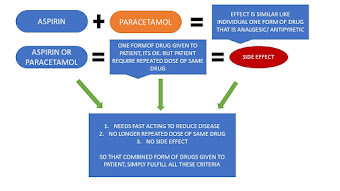Drug Synergism and Antagonism l Study Pharma l
Combined form of drugs dose
Introduction:
Drugs are given in combined form so that the effect of one drug is increased or decrease by the other drug that present in combination form.
It categories into two types:
1. Synergism 2. Antagonism
1. Synergism 2. Antagonism
Synergism:
In synergism, the effect of one drug is increased by the other drug in combination form. It is called as synergism. One may be inactive when given alone but enhance the activity of other drug when given in combination form.
In synergism, the effect of one drug is increased by the other drug in combination form. It is called as synergism. One may be inactive when given alone but enhance the activity of other drug when given in combination form.
Synergism are of two types:
1. Additive 2. Supra-additive
1. Additive 2. Supra-additive
Additive:
In additive, drugs are given in combined form and the effect of both drugs in the same direction. In other way combined effect of drug similar to individual drug only given additive form (only effect of both drugs are additive in nature).
In additive, drugs are given in combined form and the effect of both drugs in the same direction. In other way combined effect of drug similar to individual drug only given additive form (only effect of both drugs are additive in nature).
Example:
Aspirin + Paracetamol both given in combined form because both act as Analgesic / Antipyretic

Observation is this both drugs act like similar in nature, if you given only one form of drug then its OK but you need more doses of that drug which cause side effect. So our motive is to given in combination form to cure disease in lesser time with less risk of side effect.
Aspirin + Paracetamol both given in combined form because both act as Analgesic / Antipyretic

Observation is this both drugs act like similar in nature, if you given only one form of drug then its OK but you need more doses of that drug which cause side effect. So our motive is to given in combination form to cure disease in lesser time with less risk of side effect.
Supra-additive:
In supra-additive, drugs are given in combined form and the effect of one drug is increased by the other drug. One drug may be inactive in nature but have the efficacy to enhance the effect of other drug.
In supra-additive, drugs are given in combined form and the effect of one drug is increased by the other drug. One drug may be inactive in nature but have the efficacy to enhance the effect of other drug.
Example:
Acetylcholine + Physostigmine are given in combined form because physostigmine inhibit the acetylcholinesterase (AchE), the major enzyme that breakdown the acetylcholine (Ach). After its inhibition, acetylcholine amount increases in the brain.
Acetylcholine + Physostigmine are given in combined form because physostigmine inhibit the acetylcholinesterase (AchE), the major enzyme that breakdown the acetylcholine (Ach). After its inhibition, acetylcholine amount increases in the brain.
(If the patient is suffer from Alzheimer's disease, Myasthenia gravis Parkinson's disease and other Central Nervous System (CNS) related problems associated. Reason for this is imbalance in amount of acetylcholine in the brain).

Comments
Post a Comment